December was a very different kind of a month to November, starting dry and increasingly very cold. Just the needed conditions in fact to put the rivers in good order for the grayling. Experienced regular AG of Harleston in Norfolk was back at the beginning of the month, this time to fish at Cefnllysgwyne. Unfortunately on a cold, misty day he only managed 1 grayling along with 4 out of season trout. On the basis that I think AG probably knows what he is doing when it comes to catching grayling, my reading of this report gave me further concern about stocks on the Irfon.
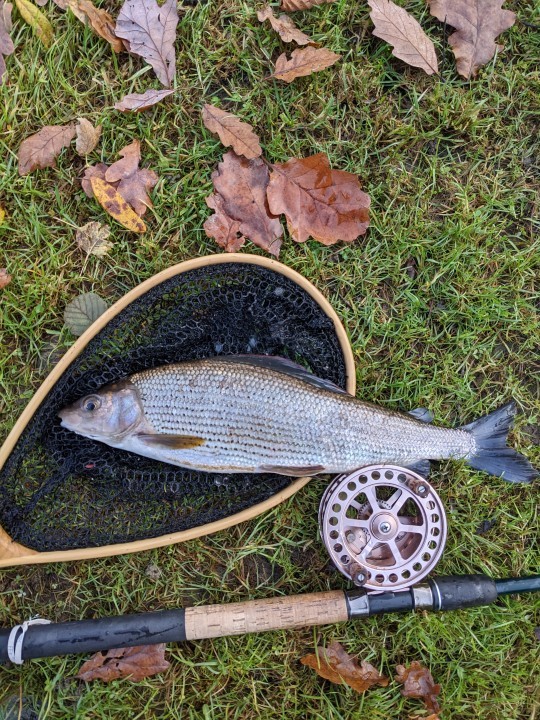 Abernant grayling - AP from Wirral
Abernant grayling - AP from Wirral On the 3rd NC from Spilsbury and his brother fished the same water by trotting with red maggots over almost the whole distance of the beat. Although between them they managed 4 grayling to 1lb 6oz, they described the fishing as “testing” although the water and weather looked about right. On the 4th they fished upstream at Melyn Cildu, also trotting maggots, and caught 6 grayling. They mentioned problems with access at the lower end of this beat due to a collapsed fence. You have to make your upstream progress from field to field there by zig-zagging across the river, which might be a problem when the level is high.
Meanwhile the main Wye was fishing reasonably well. I had a couple of good afternoons of trotting, first at Abernant and then on the Builth Town water. AP from Wirral had 11 grayling from 8-16 inches at Abernant. AG from Harleston again extracted 7 grayling to 14 inches from the upper river at Dolgau, and concurred with others that the wading here is difficult. He fished at Craig Llyn the following day and had 6 grayling, 3 of them on a dry fly during a rise. No doubt this would have been due to a winter large dark olive hatch. On the same day I was seeing olives around noon at Builth, even though the air temperature was near freezing. A few grayling were reacting at the surface too.
On the 7th TH from Swansea described his “first go” at trotting for grayling at Abernant. He had a couple of fish, which is creditable considering he was using a cheap fly-fishing reel with the drag backed off. The pull of the current was not strong enough to unload line from this, so he was confined to short trots close at hand or unspooling by hand. Hoping not to offend by giving unwanted advice, may I suggest the one really essential thing when putting together a trotting outfit is a very free running and perfectly balanced centre pin reel designed for the job? By that I mean that if you hold it in your hand and flick the spool, it should continue to run for 2-3 minutes. The spool should not always come to a halt at the same place. In fact you may well end up spending more on the reel than on the rod and some lovely pieces of engineering like the Youngs Purist range are still available. There are of course cheaper options which work well enough. You may also use a fixed spool reel, but a large diameter “pin” with a line guard and manually engaged click check is much more pleasurable. And finally 5 pounds BS Maxima would have been too heavy for the job; 100 yards of 3 pounds or 2.5 pounds nylon would do the work well enough and without tending to drag the float sideways. Have a look at my newsletter for November 2014 if you are interested in reading more on the subject of grayling trotting.
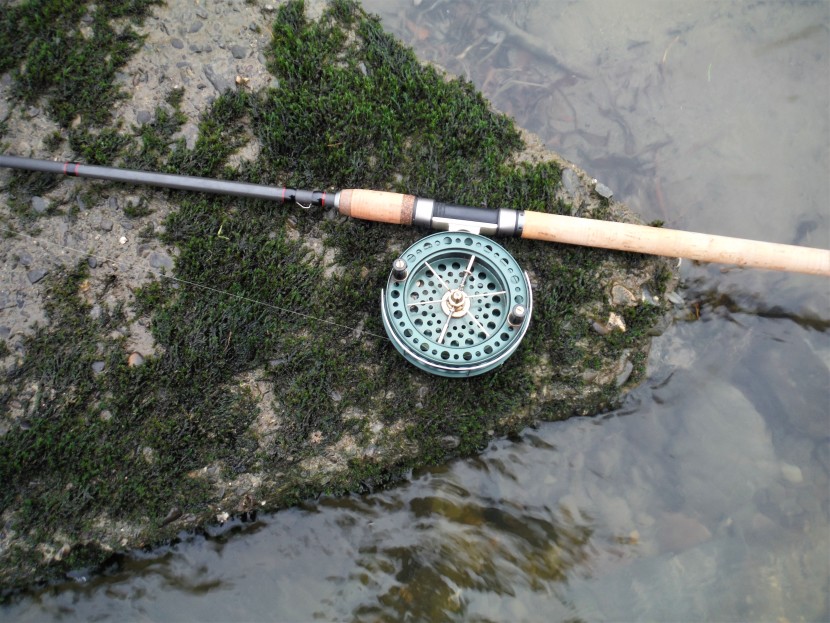 Trotting gear
Trotting gear 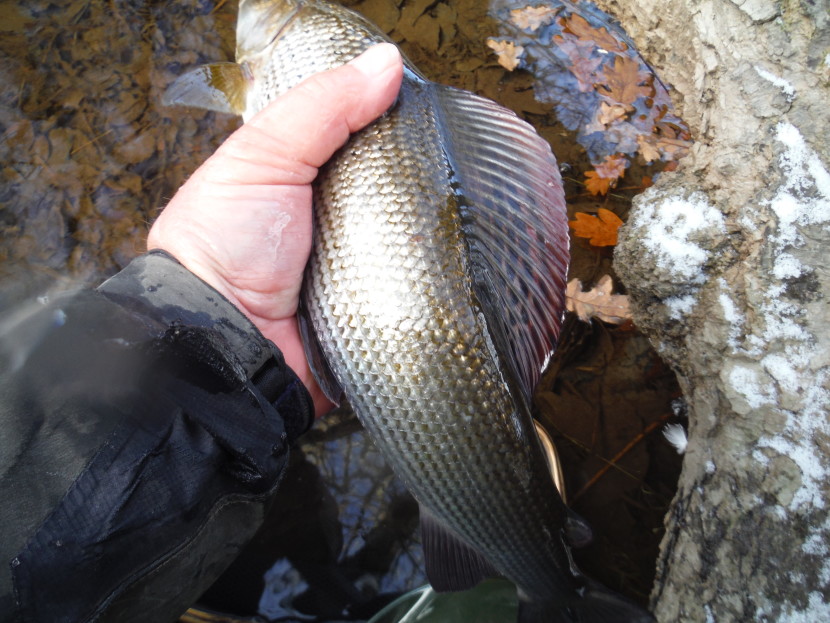 Upper Wye cock grayling
Upper Wye cock grayling PT from Kidderminster had a good day at Eyton, again trotting I presume, with 37 grayling reported and the temperature just above freezing. DS of Gloucester had an encounter with a poacher at How Caple Court; however he was not sure of the illegality of the situation until he got online back at home and saw that he was the only angler booked on that day. Poachers do well out of our uncertainty. I’m afraid we don’t have a bailiff force we can call into action to patrol the many miles of river fishing marketed by the WUF and to a large extent we rely on the common sense and prompt action of you, the legitimate anglers. My suggestion in the case of an unexpected encounter with a stranger carrying a rod is to hail him with a cheery smile, ask him if he’s booked on with the WUF, show him your ticket and ask to see his. If he objects to that, you know what the situation is, don’t you? Most poachers take off at that point, possibly after a bit of grumbling, but don’t under any circumstances put yourself at risk by pushing the point if he doesn’t. Leave the scene and make the appropriate phone call at once. Theft of fishing rights is a police offence, so make your call first to the police.
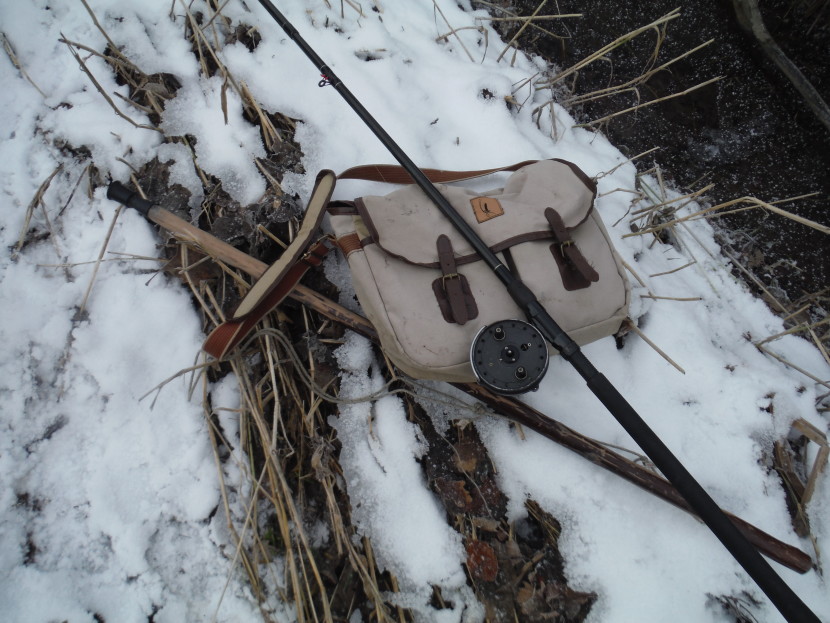 Vintage trotting tackle
Vintage trotting tackle 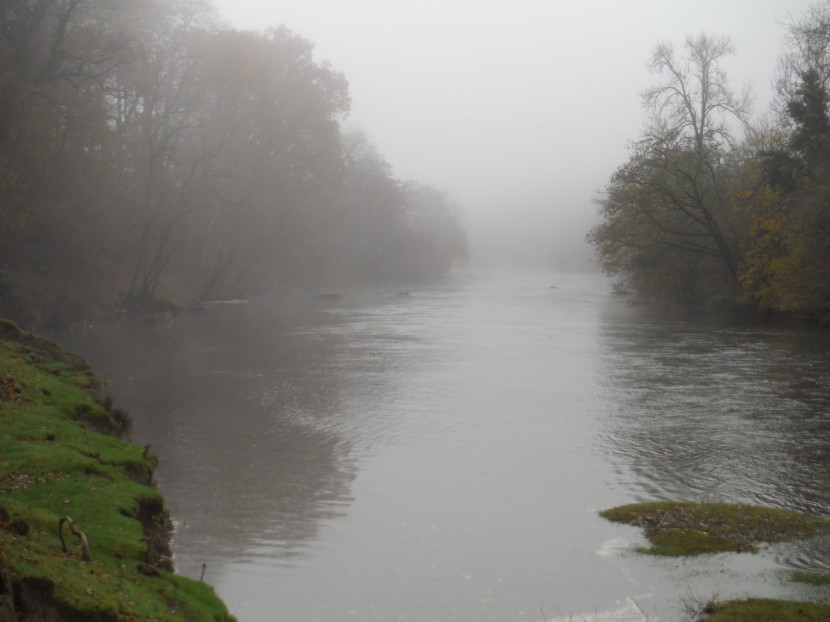 Winter on the upper Wye
Winter on the upper Wye I wrote earlier that grayling anglers should be happy when the weather is dry and cold. Well we certainly had those conditions all right during December, which was almost the opposite of November. The rivers came into fine trim, but it was now becoming very cold and more so as the month went on. At short notice and after some hesitation I went for a morning session on the upper Wye near Rhayader. Although the main roads had been gritted enough to give me confidence, I arrived in a sort of winter wonderland with everything white and the thermometer at minus 6 degrees. Initially I felt somewhat daunted. The ground was iron hard, the sky over the Cambrian Mountains clouded and fresh snow was gently starting to fall. However, the river was obviously in a fine state, with the pools gliding down black and smooth between the white banks. Also I had a ploy ready for the kind of cold conditions which lock rod rings with ice in the most infuriating way, which was to use an outfit without any rod rings at all. A 12 foot Tenkara rod to the tip of which was attached 8 feet of tapered braid and 5 feet of fluorocarbon with an indicator and a pair of bugs gave me as much reach as I needed, short of trying to fish right over to deep water and the opposite bank. I had what I thought would be a solution to that also, but it wasn’t needed. The first glide and pool tail tried had a cormorant working it when I arrived, so there was nothing doing there. But the next one produced three small grayling and the one above that a long, lean post-spawning trout followed by four larger grayling, both cocks and hens, up to 16 inches. Interest was shared about equally between a Pink Shrimp and a Tungsten Hare’s Ear. The water, considerably warmer than the air, was not uncomfortable to wade and in fact a thaw had just started when I had to leave.
The slight warmth in the air didn’t last long and a fall of overnight snow had many roads in the Forest of Dean closed the next day. More snow followed, causing trouble in many parts of the country, and Gloucestershire suspended bus services in the Cotswolds and the Forest of Dean. Sun rising in a clear sky over a frozen landscape can be a beautiful thing. From where we live I can sometimes see two low winter suns in the east: a fiery orb rising over the distant Cotswolds, its deep red reflection in the waters of the Severn and a red tint to the fields of white closer at hand. Low temperatures seemed to be locked in and not so many of us were prepared to turn out with fishing rods in these circumstances. Understandably, a brisk walk in the frosty countryside followed by a hot mince pie and a glass of ginger wine was more attractive. Each succeeding day seemed colder, although there was very little wind. Our Forest Pool froze over. I couldn’t even get up to Mork for my Sunday morning’s shooting and I was beginning to miss the Landrover we sold last year. I just knew at the time that I would regret it, sooner or later! A few anglers kept trying, snow and low temperatures notwithstanding. On the 9th AP from Wirral fished with the trotting rod at Abernant and was bothered with large numbers of out of season trout. He did, however, take 10 grayling to 14 inches. Stuart Layzell from Hockley Heath had just the one grayling there with the fly rod on the 10th.
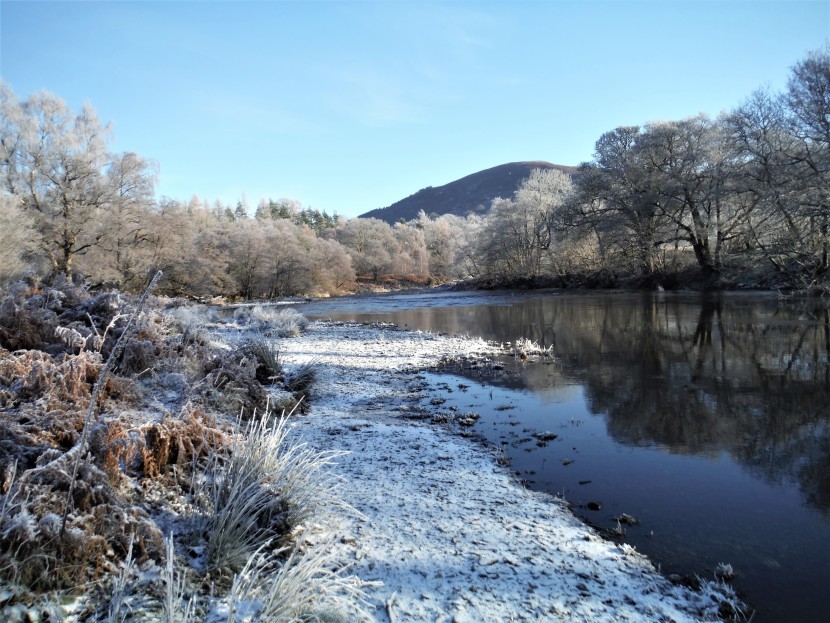 Craig Llyn 101222B
Craig Llyn 101222B 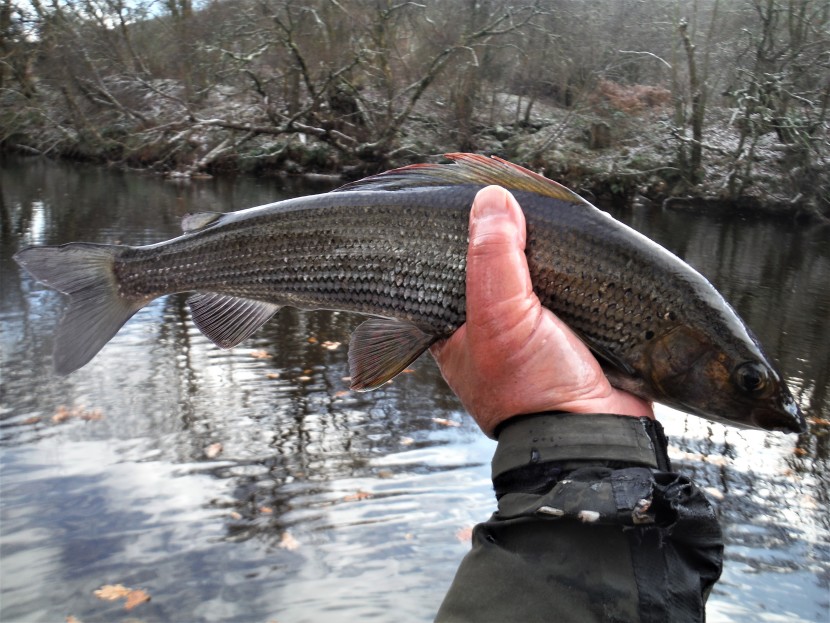 Craig Llyn grayling
Craig Llyn grayling During the next week the weather remained dry and still but remained very cold indeed, with the thermometer failing to climb to zero on most days. The rivers were still in good condition, although ice had now started to form in the margins and ponds everywhere were already frozen over. Understandably, anglers were not so keen to turn out, particularly given the problem of icing rings which affects both fly and bait rods. Then on 18th and 19th December everything changed as low pressure took over. The temperature shot up quite quickly into double figures as the first warm front came over us. We were threatened with snow as warm moist air clashed with cold, but instead we got 24 hours of really heavy rain. At the end of that and before any advantage could be taken, we found all our rivers unfishable due to flood and that is how they stayed. The days of Christmas and the rest of December were warm and wet, with as far as I could see no possibility at all for grayling fishing. Rainbows in ponds were all that remained! There might be some late reports coming in after the holidays, in which case I will update you in the New Year.
 Forest pool frozen
Forest pool frozen 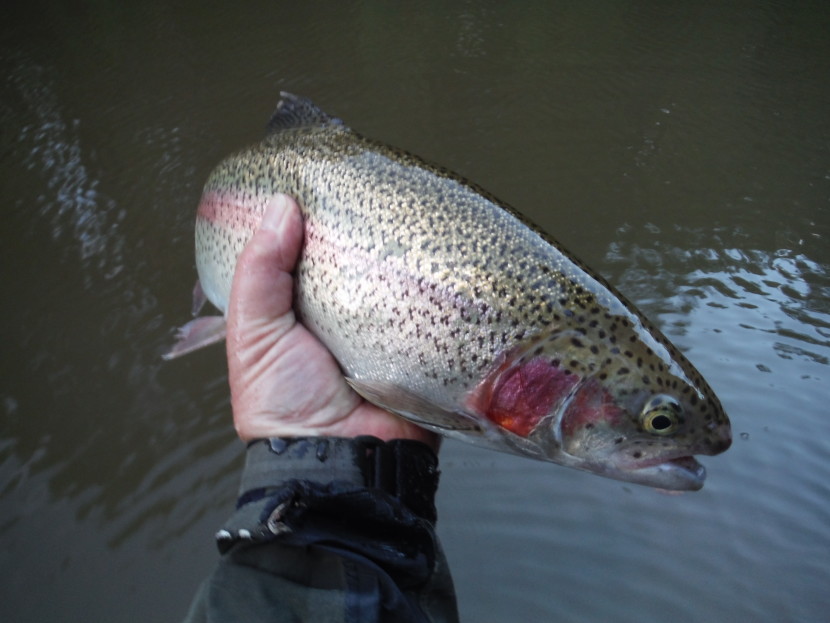 Rainbows in ponds
Rainbows in ponds The Irish judge Kingsmill Moore, writing in his much-admired A Man May Fish, that great story of an angling life, recounted a conversation he once had with Jamesie, the legendary Connemara boatman. I calculate this would have been at some time during the late 1920s. Jamesie, in his famously roundabout and loquacious way, was remembering a visiting English angler, a very good one at that, who had once engaged him and what is more had a bet with him about the best team of flies to be used on those great limestone lakes of the West. Needless to relate, Jamesie had won the bet about the successful flies or he wouldn’t have told the story. Jamesie had much to say about this angler, as indeed he had much to say on most subjects, and yet could only remember that his name had something curiously repetitive about it. “You can’t mean Francis Francis?” hazarded Kingsmill Moore after scratching his head. “That’s the very one, sir!” responded Jamesie. Now the judge was not completely sure about this, knowing full well that the exact truth was not always in Jamesie and certainly would not be allowed to get in the way of a good story. But as Jamesie was in his eighties by then, it was perfectly possible that he might have linked an early 20th century angler with a mid-Victorian one.
The name Francis Francis crops up often enough in the angling literature of the 19th century. The famous predator angler Alfred Jardine devoted the final chapter of his Pike and Perch (which was published in 1898 towards the end of a long angling life dedicated to putting large pike into glass cases) to describing a few days’ holiday with his friend “the late Mr Francis Francis, cheerfullest of companions.” This described autumn holiday takes place in the region of Bramshill Park in Hampshire, later to become the police training college, and around the Duke of Wellington’s Strathfield Saye Park and the little rivers Loddon, Blackwater and Whitewater. It’s interesting to reflect that, today, these are known as no more than minor rivers from an angling point of view, perhaps worth a day out from Reading, but 150 years ago the fishing seems to have been wonderful. The pair arrive and depart by rail, but are driven around the rutted lanes in a horse-drawn wagonette belonging to a local friend in whose farmhouse they stay; meanwhile keepers are on hand, as are substantial packed lunches “…a cold loin of roast pork and other toothsome fare from my friend’s farm, also a large stone jar of brown October ale.” Jardine describes what seems to have been some quite marvellous late autumn fishing in fine weather and delightful scenery as the pair catch jack to 7 pounds, perch and chub from holes in the river with paternostered minnows and worm, and then some huge pike in the lakes using a 5 inch dace spun on a wire trace and also live baits. Jardine describes Francis hooking and losing an estimated 30 pounder, but as it is the pair manage to take (and kill) larger pike to 19 pounds. To be fair about this, in modern times the veracity of “father of pike angling” Jardine in regards to weights has been questioned, but let it stand. Why spoil a good story? Meanwhile their host and friend had come along with his gun and shot some duck at the other end of the lake. Jardine also describes an evening back at the farmhouse with two neighbours and a cattle dealer and contractor for Aldershot camp, “…jolly fellows and good all-round sportsmen. Francis Francis was exactly in his element; and with much chat about angling, shooting and coursing, we passed some very pleasant hours, until the near approach of midnight broke up our merry party.” Jardine describes another side of Francis Francis the following day, after a keeper persisted in telling him to try fishing another part of the lake where a friend of his caught a large pike the previous year. We all know how annoying this kind of unasked for advice can be, particularly while trying to concentrate on fishing, and Francis eventually lost his temper and sent the keeper off with a flea in his ear. Later the young GEM Skues, then a schoolboy at Winchester, had Francis Francis pointed out to him while the famous editor in later life was fishing the Old Barge water of the Itchen with an old-fashioned two-handed trout rod.
So who was Francis Francis and, to begin with, why the slightly curious name? He was born in 1822 at Seaton, Devon, son of Captain Morgan of the Royal Navy and Sarah Robinson Hartley. He had a good education, particularly in the classics, and eventually qualified as a civil engineer. On achieving his majority, however, he inherited from an uncle a substantial fortune in property on the slightly eccentric condition that he changed his surname. This sounds like an incident from a Dickens novel, but Francis wisely complied and in newly comfortable circumstances was enabled to abandon engineering and devote the rest of his life to sport and to writing about it. In 1851 he married Mary Cole of Oxford and, based now in London, had a very happy time working for 25 years as Angling Editor of The Field. The job involved travelling widely to experience every kind of angling. He was fit, energetic, intelligent, and fascinated by his chosen sport. The kind of all-round angler he exemplified is much more unusual today, but The Field reckoned to cover all aspects of the sport and Francis Francis was as interested to talk to a pole fisher for roach on a Thames tow-path as he was comfortable with an angler wielding a double-handed rod on an expensive Scottish salmon river. For him angling was indeed the great leveller, as it often is today. He had an omnivorous appetite for every kind of angling information and talked with and listened a good deal to the old Thames anglers. Above all, he had all the qualities of a really good editor: knowledgeable, objective, encouraging and socially adept. In modern parlance, we would say that he networked well. According to contemporary accounts, he had something of a temper which would show itself now and then, not without reason, but he was also generous in making his apologies. He could certainly recognize good writing when he saw it, being a masterly writer himself, perhaps the best of 19th century angling writers. He was a great advocate of fish breeding, one of the directors of the Brighton Aquarium, and did much to promote the stocking of New Zealand and Tasmanian waters with English trout as well as campaigning against the pollution of the Thames. Unfortunately his last years were marred by debilitating illness. In 1886 he died at home in Twickenham, where in the churchyard his tomb may be seen engraved with two lines by Izaak Walton: “And angle on and beg to have, a quiet passage to a welcome grave.” It is rather nice to know that members of The Francis Francis Angling Club of Twickenham still fish the Thames from punts in the style with which he would have been familiar.
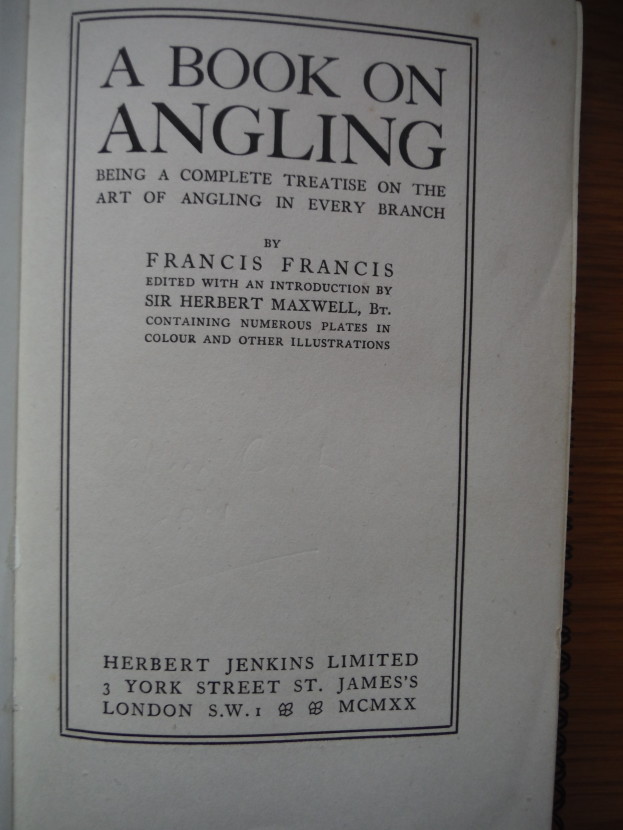
Apart from his work as editor at The Field, Francis Francis wrote and published a good deal throughout his life, beginning with novels and stories. One work I have not been able to find much about is A Diplomatic History of the Greek War, which he wrote as a young man, although it was not published until 1878. I am assuming that the Greek independence war of 1821-8 was the subject. In later years he confined himself to writing about angling, which was so very much his subject – and, I suppose, publishers may have advised him that angling was a large and lucrative market. Everybody seems agreed that the best of his writing is one work simply and logically entitled: A Book on Angling.
And what a book it is, despite the modest title! Published first in 1867, it covers every aspect of angling in a depth of detail which made it the reference point for other writers on the sport for decades to come. You can clearly see its influence on 20th century works such as E Marshall-Hardy’s Angling Ways, which in its turn informed me when I read it during the 1950s. Francis Francis seems to have had a remarkable memory and encyclopaedic knowledge of his subject, but his writing expresses that vast store of information in a way which never bores. You immediately get the message that this is a man who knows what he is talking about and just occasionally there is that little hint of temper and impatience with perceived foolishness to spice up the narrative. We are listening here to a man of strong views then – although nothing to compare with those of Hugh Falkus later – but it’s none the worse for that. My copy is the second edition brought out in 1920 with an introduction by Sir Herbert Maxwell, who cannot resist some editing of his own, sometimes quite intrusively. Much had changed for the better particularly with tackle manufacture over the intervening 53 years. Francis Francis’s two handed trout rod of 14 feet would have seemed distinctly outdated by 1920, but the rest of what he had to say seems largely relevant even now. The fly-leaf of my copy bears the name of one LT Lloyd, who was apparently gifted the book in 1934.
After a little bit of history, including the usual and almost obligatory references to Dame Juliana Berners, Walton, Cotton and Venables, Francis starts us off with the coarse fish and before going into actual species he divides the art into bottom, mid-water and surface fishing. Bottom fishing, firstly on ponds and then in streams, is a very good place to start and he explains rods, reels, quill floats, split shot, plummets and all the paraphernalia which a Nottingham or London roach fisherman would have used to fish from the bank or a punt. At once we start to receive wise advice offered in succinct prose: “I generally use a hook of not quite a round bend, but with the point deflected to the side a little (not too much) and bent inwards the least trifle in the world; and added to this I do not hold with the shank being too short. It is a great fault.” Later there is a whole chapter on hooks, but those two sentences tell us a lot. There is a brief evocation of mid-19th century Pax Britannica and the pleasures (and perils perchance) of then fashionable gudgeon fishing parties on the Thames with attractive young ladies. But he doesn’t dally long with that idea, because he has much more to impart about ground-baiting and float fishing for roach, dace, chub and barbel. By the standards of the day, he was a believer in very sparse ground-baiting, but still it was a grizzly business, involving butcher’s greaves and bullock’s brain as well as worms and gentles, wasp grubs and the rest. He liked a lampern tail as a bait for barbel, using the blood, head and intestines as ground-bait. It becomes apparent from his discourse that, due to the recent arrival of the railway, angling had for the first time become a sport for the masses, including town dwellers. We also realise that this was a time when coarse as well as game fish were commonly taken for the pot. He has this to say about the idea of eating barbel: “It is a coarse, watery, flavourless, bony fish, and of little value for the table unless it be used as stock for fish-soup. Albeit I have seen fishermen eat them, first, however, splitting them down the back and taking out the back-bone.” He mentions that there are barbel in the Crimea, which Englishmen engaged in the recent war had no doubt discovered. He writes about much more than his local Thames, for example remarking accurately that there are chub in the Wye and the Irfon and, oddly enough, relating that pools in the Usk below Brecon were full of some very large dace. Really? On reading this I wondered for a moment if he had been deceived by seeing shoals of silver shad in the Usk when he visited Brecon. There is a description of a Thames barbel foul-hooked on roach tackle which he played for hours into the night. Spying some workmen nearby, the gentlemen-anglers in the party called for lanterns, hot brandy and water. Those were the days, assuming the requested commodities arrived promptly! On the barbel of the Thames he writes: “One hears of twelve pounders often, but one does not see them weighed, and Thames water, from its strong magnifying powers, should be used for microscopes.”
Francis goes on to describe what was known then as “Nottingham style fishing,” which was fairly similar to what we would call long trotting with a centre pin on a big river today. The reel in the time of Francis would probably have been wooden, but otherwise the technique with a 13 foot rod is quite familiar. This was mostly used with small worms for roach and dace, but slightly heavier tackle would be used if chub and barbel were expected. Should a barbel be hooked on light gear, Francis advises casting the punt loose from its mooring poles and trying to get below the fish, drifting down and playing it into “unfamiliar territory” away from its holt. He extends the range to deal with bream, always using tackle as fine as possible, and describes some famous bream holes on the Thames and Middlesex Colne.
On the subject of carp Francis is slightly disappointing as, while appreciating that carp can grow to 20 or even 30 pounds, he obviously subscribed to the general view of the day that the monsters were so cunning and strong as to be virtually uncatchable. He therefore, apart from the usual advice about extreme caution and careful ground-baiting in advance, recommends the sort of float tackle we would normally use for tench and states that in his experience a 4 pounds carp would be a good catch. On the other hand, he quoted a Mr Goodwin who used to fish in the Long Pond in the park at Hampton Court using a parboiled potato and a heavy ledger. Mr Goodwin used to make “wonderful takes of very large carp, up to fourteen or fifteen pounds each.” I can imagine! Francis has much more to say about tench, not so much because he was an expert at catching them, but because he clearly found them fascinatingly difficult, both to find in various ponds and to hook them when in a shy-biting mood. He also liked to eat them, “the flesh white, firm and sweet,” and admired their tenacity of life when being transferred from one water to another. Francis mentions the kitchen in regard to all the fish he catches; in that department we have changed perhaps the most from his time (although I have seen live tench and roach for sale at the Vittorio Emanuele market in Rome). As already mentioned Francis doesn’t much like eating barbel or even carp: “…he is not worth eating, being a muddy, bony, woolly beast, on whom any sauce or condiment is simply wasted.” Similarly and having tried them he did not think much of Thames bream, but admits they were a popular food fish on the Trent.
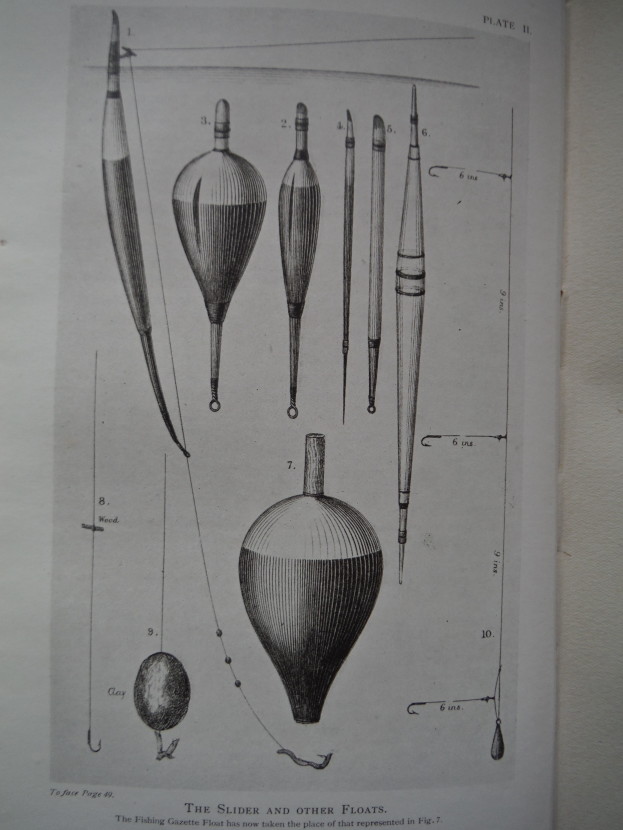 Fishing floats
Fishing floats 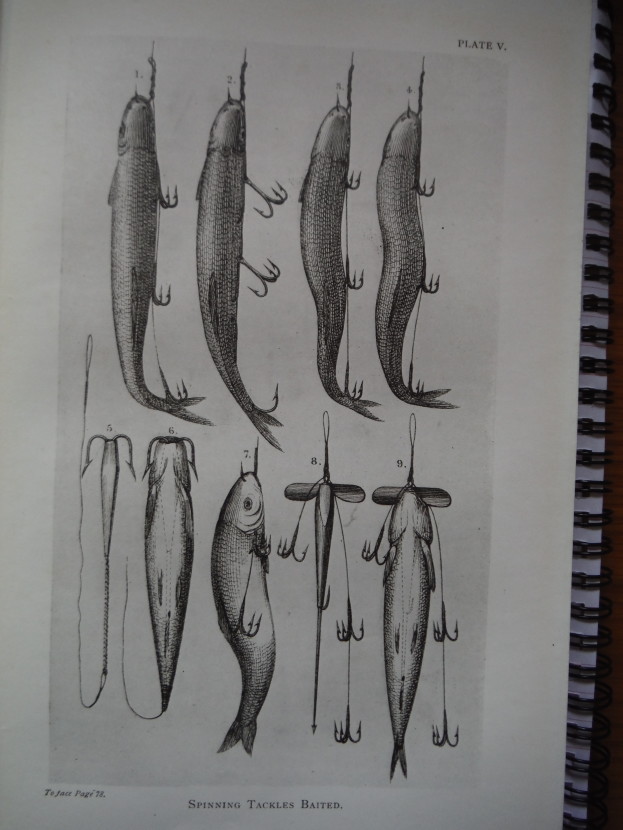 Flights baited
Flights baited When he comes to eels, Francis is obviously more concerned with the culinary possibilities than any prospect of sport, although he does suggest a rod and line, with or without a float, and a number 6 hook and a worm. Provided the worm is on the bottom, he opines, the eel will take it. Commercial eel fishing then was done with bucks, pots or wheels, which are woven baskets set up on weirs. I can remember one of these which used to be on the weir in Blakeney village. Or, in winter, they might be speared with barbed tridents thrust into likely holes in the mud. Gloucester Museum has an eel spear or glaive of this type. Francis describes sniggling for heavy eels, a brutal business which involved a double-pointed sharp pin tied to light cord and attached to a fine pointed stick about 10 feet long. The pin was hidden by a carefully baited lobworm; the eel would take it whole and on tightening the pin would turns sideways and jam in the eel’s gullet. This worked in the same way as the wolfsangel trap of Eastern Europe, by which a gobbet of meat with a concealed sharp pin would be hung from a tree by a chain. Wolves don’t chew; they swallow their meat in chunks and so would be left hanging in agony as the spike turned crosswise in the gullet. Clod fishing for eels would be done best from a punt and was popular on the Norfolk Broads. Fishers would attach a mass of lobworms threaded onto a loop of worsted to a rod and line and dibble the bait on the bottom. When the pull of an eel was felt, the whole rig would be gently lifted and swung over a pail ready in the boat. The eel would have its jaws entangled and would hang on until given a shake over the pail. Stitchering was used in Hampshire and the equipment consisted of a notched old sickle attached to a 12 foot pole. The idea was to spot an eel lying in one of the water meadow drains and hook it out quickly from underneath to throw it on the bank. I imagine that chalk stream clarity would have been essential for this. “An unskilful sticherer will sometimes chop off his neighbour’s ear, or poke out his eye, which doubtless lends excitement to the sport.”
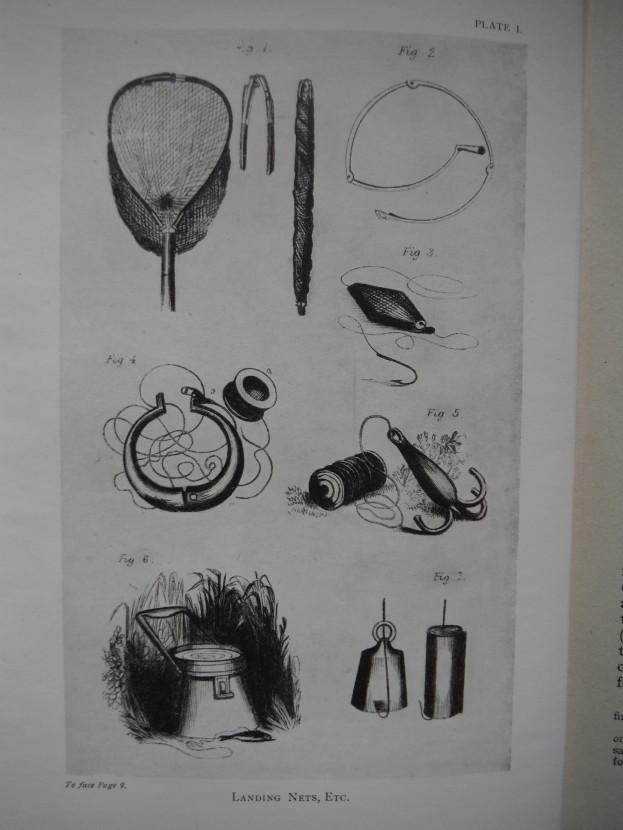 Landing nets etc
Landing nets etc 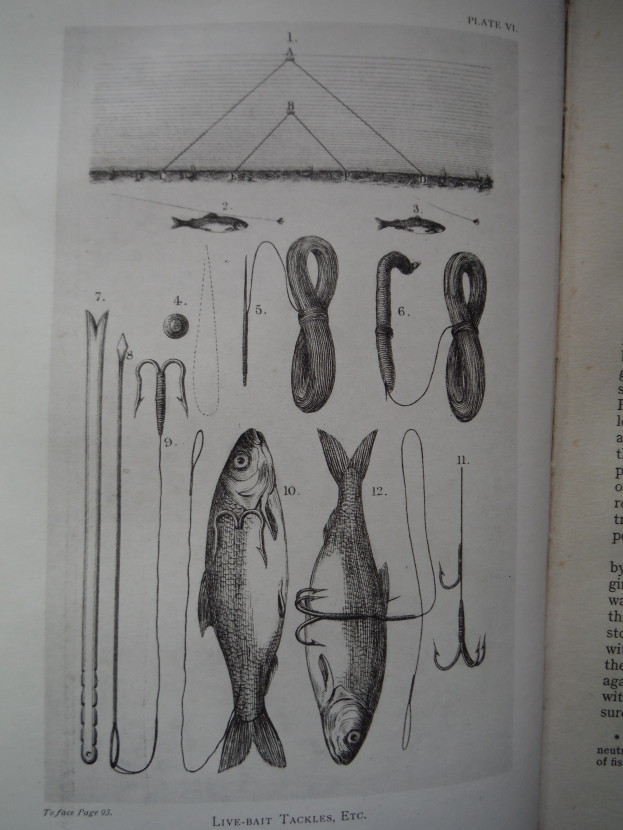 Live baits and dead baits
Live baits and dead baits Francis Francis has much more to say about fishing for perch “a bold, biting fish.” He makes the point that they are sometimes shy, which is certainly true, but I remember when I was a school boy we loved fishing for perch. The methods we used were float fishing or paternostering with worm, live baiting with minnows or a small gudgeon, or occasionally spinning with a Mepps spoon. Live baiting is a method much less favoured today, but all these methods are described in detail by Francis: “The best day’s perch fishing I ever had was on the Kennet, a capital perch river. I fished with a friend and we took home thirty seven perch which weighed sixty pounds – many of them weighed two pounds and some were over that weight.” I wonder what one would do with 60 pounds of perch taken home today? Even in my school days perch were more common than they seem to be now and we were delighted to catch them. I have eaten them on occasion and can’t particularly recommend them.
The next 30 pages are given over to pike, a coarse fish which certainly claims Francis Francis’s attention. He was, after all an enthusiastic salmon fisher, and the dread pike is often capable of engaging the salmon fisher’s interest. They are both large and powerful fish and then there is a sort of extra fascination created by the murderous glare of the cold-eyed pike. It’s a fish sinister enough to generate legends easily enough and Francis repeats some of them. Thus we have the pike which weighed 170 pounds when caught from Lillieshall Lime Works in 1765 and which reportedly had chased the clerk of the parish council when he was swimming there earlier. Also the pike skeleton in Mannheim Museum which was supposedly 19 feet long and 267 years old when caught. This was investigated by Cholmondeley Pennell and it was found that a number of the vertebrae in the skeleton had been added. Having dealt with the legends, Francis eventually admits that in Britain pike might grow as large as 80 pounds, while his own “personal best” was 22.5 pounds. While he doesn’t discuss culinary possibilities, it’s obvious from Francis’ writing here that all but the smaller jack pike were being killed by most anglers. I am not clear whether this was for food, or for trophy hunting. Certainly anybody who caught a 20 pounder was likely to have visited the taxidermist afterwards.
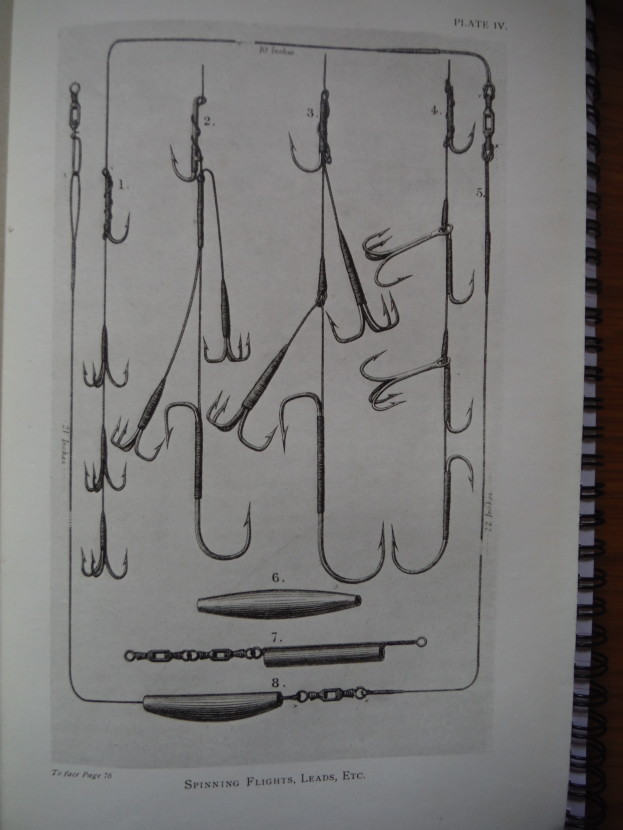 Spinning flights
Spinning flights Francis begins with spinning, usually in those days with a dead dace, bleak or similar mounted on a flight of trebles. He had learned the craft from Thames fishermen, “the best spinners in all of the world” and of course his tutors would also have fished for Thames trout in the weir pools. He refers often to Cholmondeley Pennell’s book on pike fishing and there is a reference to the recent introduction of agate or porcelain rings to avoid the grooving which affected ordinary metal rod rings. The tackle he used consisted of a two handed 14 foot rod and a centre pin reel, the casts being made from coils of line laid on the ground. After casting, the bait would be worked in much as a salmon fly would be on a two handed rod. “A big spoon is good” he opines and he was also prepared to experiment with live frogs, mice, dead birds and rats. His friend Samuel Baker, African explorer and sometime Governor of Ceylon, had constructed a spinning bait from an old daguerreotype, copper plate with silver on one side. Francis describes spinning on the Hampshire Avon with the head and tail of an eel mounted on a single hook and then hand-lined back. He also recalls fishing with Alfred Jardine in extreme winter conditions at Downton near Salisbury. In general though, he is wary about betraying locations: “…good pike fishing is far more scarce than good salmon fishing and is much more easily spoiled…Had I the management of a good pike water, I would allow nothing but spinning and no fish under four pounds to be killed.”
Although Francis later gives details for gorge fishing methods – this was an age in which pike were killed as vermin in many waters - he makes the point early that if smaller pike are to be released, some less damaging arrangement of hooks should be employed. He also writes at great length about striking pike and emphasizes the important point that the more barbed treble hooks a bait is festooned with, the more likely it is that the hook hold will come loose. It takes a great deal of strength to strike a large number of trebles into a secure hold in a mouth which is largely gristle and bone. Today I think we understand this better and modern dead baits are lightly armed, sometimes with barbless hooks, according to local regulations. We used to fish for pike with sprats using a single number 6 hook to wire or perhaps a small herring and a single treble and these used to hold well enough. A century earlier Francis Francis was recommending no more than two trebles for his spinning baits, which was a modest arming compared with the three and four treble flights commonly in use at the time. Francis was much more interested in spinning than any other method and he comments in his book that many anglers then were not comfortable with the unpleasant process of mounting live baits, even on snap tackles which were considered relatively humane. There are some interesting ideas when he comes to tactics, such as to swim a Newfoundland dog to move pike out of flag and reed beds into open water. However, when it came to clearing pike from a water according to the owner’s instructions, he was quite prepared to use gorge tackle. He wondered if Mr Stewart, landlord of the Star at Fordingbridge, would remember the 36 pike he took in a day from the Avon there, thus sparing the expensive trout stocked in that river.
So much for Francis Francis who occupied nearly 100 pages of his book in describing coarse fishing. There are 250 pages more from him on game fishing, but that must wait for another occasion.
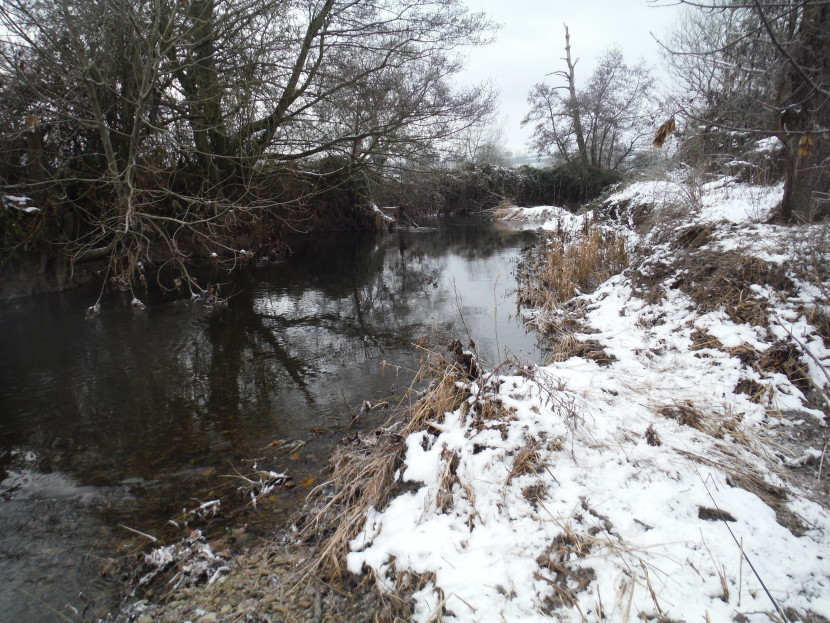 The Arrow in winter
The Arrow in winter 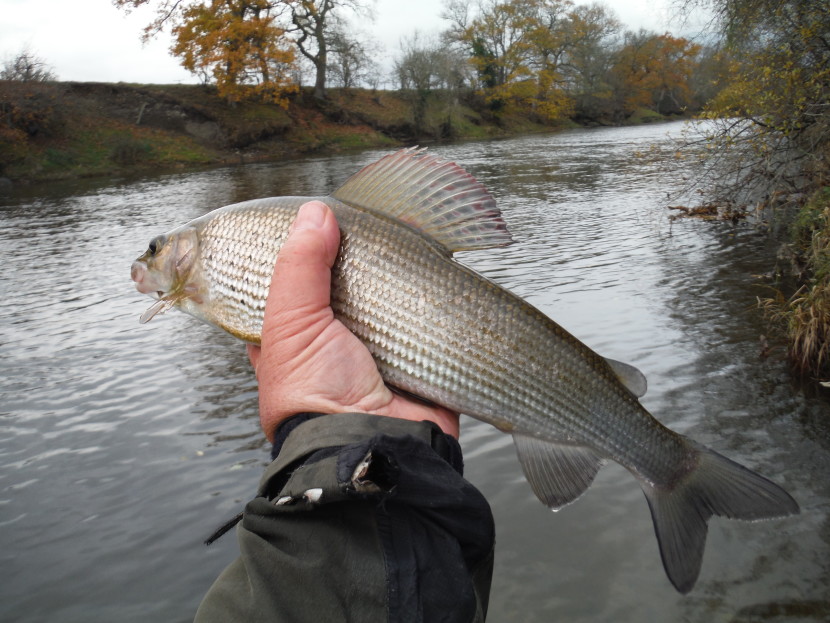 Builth Wells grayling
Builth Wells grayling 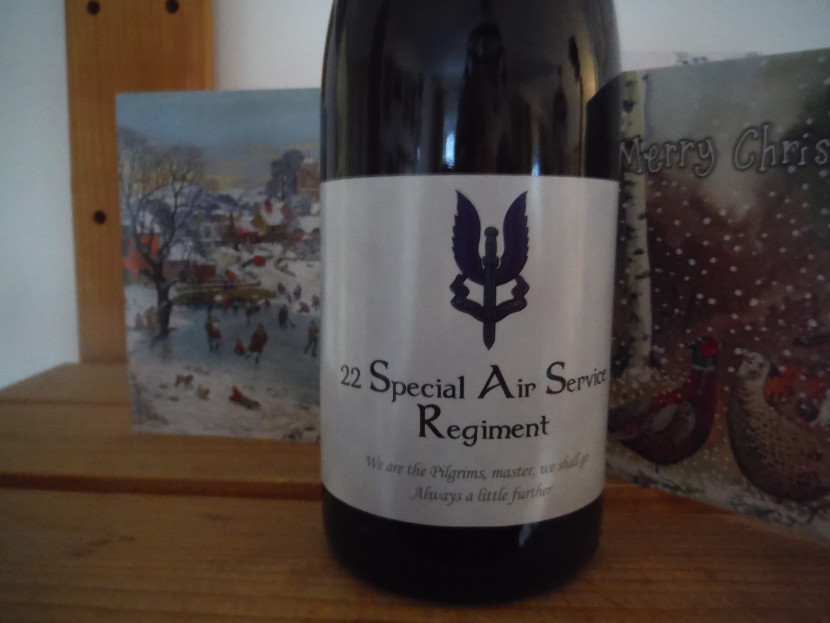 Christmas cheer
Christmas cheer Our children threw us a sort of pre-Christmas party this year and this coincided with the snow. The only problem was the venue; the cottage we live in today is nice for two people and a load of fishing tackle, but has a lot less space for visitors than the previous house on the hill.
The solution turned out to be what is still shown on Ordnance Survey maps as a water works up by the spring in Ferneyley Wood. This is in fact the Victorian pump-house which once used to lift water over the hill to the Deer Park and the Estate’s big house. It is reached by a long gravelled forest track and stands alone in a clearing beside a deep pool in a little garden defended from the depredations of boar and deer by a fence. Today there are rainbows stocked in the pool and a line of poles leads power up from the village into the old stone building with high ceilings and giant semi-circular windows which I imagine once housed a steam engine. After conversion with bedrooms and kitchen it’s warm and comfortable for visitors to live in, even on a cold winter night with snow-covered woods all around.
I was worried about the snow, thinking that the forest track might be blocked, but I need not have been concerned. Malcolm and Keisha who organised it all came over early from Sussex with presents, collecting turkey and wine on the way. Medina finished her last day at Credenhill and drove over after dark from Hereford, with her little Corgi dog, regimental wine this time, and more presents in the car. After Christmas she starts training new recruits at Lichfield. Danny her fiancé, who works at Army HQ in Andover, arrived last from the Hampshire downs and somehow manoeuvred his low-slung BMW over the bumps in the track to join us. In the face of all this effort Nerma and I felt slightly fraudulent, having come no more than a few miles up from home to join them. There was a delightful start to the evening in the giant kitchen, drinking toasts and savouring the cooking smells emanating from the range. Everybody fancies themselves a gourmet expert at such times: how best to turn and baste a turkey; what spices to put with red cabbage; how to make dauphinoise potatoes. After dinner, we all sat by flickering candle light while opening presents. For once the television was off and there were crackers to pull and Christmas games to play.
Happy New Year to all,
Oliver Burch